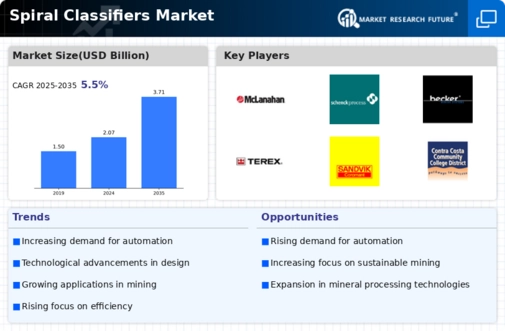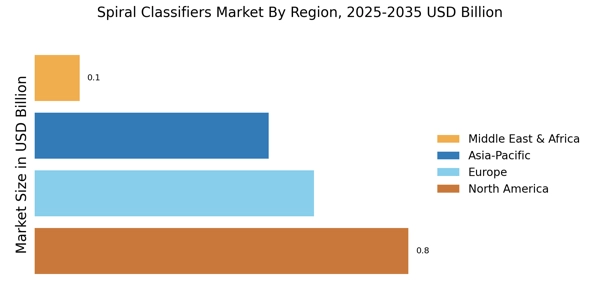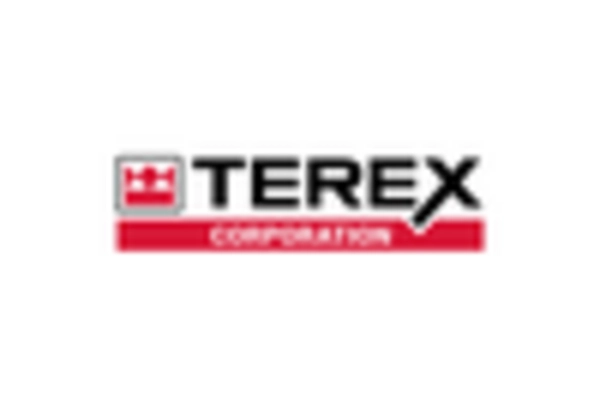Rising Environmental Regulations
The Spiral Classifiers Market is increasingly influenced by stringent environmental regulations aimed at reducing waste and promoting sustainable practices. As industries face pressure to minimize their ecological footprint, the adoption of spiral classifiers becomes more appealing. These classifiers not only enhance material recovery but also contribute to waste reduction by efficiently separating usable materials from waste. Regulatory frameworks are evolving, with many regions implementing stricter guidelines for waste management and resource recovery. This shift indicates a potential growth opportunity for the Spiral Classifiers Market, as companies seek to comply with regulations while optimizing their operations. The market could see a rise in demand for classifiers that are designed with sustainability in mind.
Increasing Demand in Mining Sector
The Spiral Classifiers Market is experiencing a notable surge in demand, particularly from the mining sector. As mineral extraction processes become more complex, the need for efficient separation and classification of materials intensifies. Spiral classifiers are essential in this context, as they facilitate the separation of fine particles from coarse ones, thereby enhancing the overall efficiency of mineral processing. Recent data indicates that the mining industry is projected to grow at a compound annual growth rate of approximately 5.2% over the next few years, which could further bolster the demand for spiral classifiers. This trend suggests that manufacturers in the Spiral Classifiers Market may need to innovate and adapt their offerings to meet the evolving needs of mining operations.
Expansion of Construction Activities
The Spiral Classifiers Market is benefiting from the expansion of construction activities across various sectors. As infrastructure development accelerates, the demand for materials such as sand, gravel, and aggregates increases. Spiral classifiers are crucial in the construction industry for the efficient separation and classification of these materials, ensuring that they meet quality standards. The construction sector is projected to grow significantly, with estimates suggesting a growth rate of approximately 6% in the coming years. This growth is likely to drive the demand for spiral classifiers, as construction companies seek reliable solutions for material processing. Consequently, the Spiral Classifiers Market may experience a positive impact from this trend.
Technological Innovations in Equipment
Technological advancements are playing a pivotal role in shaping the Spiral Classifiers Market. Innovations in design and functionality are enhancing the performance and efficiency of spiral classifiers. For instance, the integration of automation and smart technologies allows for real-time monitoring and adjustments, leading to improved separation processes. Furthermore, advancements in materials used for manufacturing classifiers are contributing to increased durability and reduced maintenance costs. As industries seek to optimize their operations, the demand for technologically advanced spiral classifiers is likely to rise. Market data suggests that the equipment sector is expected to witness a growth rate of around 4.5% annually, indicating a robust future for the Spiral Classifiers Market.
Growing Focus on Mineral Processing Efficiency
The Spiral Classifiers Market is witnessing a growing focus on enhancing mineral processing efficiency. As global demand for minerals rises, industries are compelled to optimize their processing techniques to maximize yield and reduce costs. Spiral classifiers play a vital role in this optimization by providing effective separation of materials, which is essential for improving overall processing efficiency. Recent studies indicate that the mineral processing sector is expected to grow at a rate of around 5.5% annually, driven by the increasing need for efficient resource utilization. This trend suggests that the Spiral Classifiers Market could see a significant uptick in demand as companies strive to enhance their operational efficiency and meet market demands.


















Leave a Comment